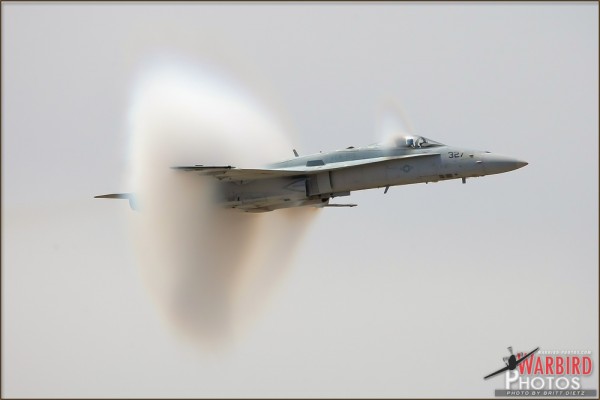|
|
|
|||||||||||
|
Occasionally, you’ll shoot that one photo that really stands out above the rest. Sometimes it can be totally unexpected, and you don’t even realize it until you see the photo on your computer. Other times, you can see the photo falling into place allowing you to click the shutter button at the exact moment that you know you’ve caught your own personal masterpiece. Ever so often I’m going to showcase some of what I personally think are interesting and pretty cool photos I’ve taken, with a bit of info behind the photo and how it all came into place. First up is a photo from recently, in fact it was from last Saturday (August 7, 2010). I was at the Naval Base Ventura County Point Mugu Airshow, an airshow that has been on hiatus for 3 years. The long-awaited show is a favorite among photographers and aviation fans for one simple reason: VAPOR. Being one of the few aviation bases basically on a beach, the high moisture in the air causes extreme vapor on aircraft which is why the show is often called ‘Vapor Fest.’ Vapor on aircraft is actually called ‘Prandtl–Glauert singularity,’ which is basically the point which a sudden drop in pressure happens usually due to turbulent air caused by the surfaces of an aircraft or nearing the supersonic speeds that cause instantaneous clouds to appear around certain surfaces of the aircraft as the water molecules in the air condense. WHEW! It can be as simple as little vapor spots forming around the wings of aircraft at high speeds or entire cone shaped clouds momentarily forming around the aircraft as it approaches mach 1 and the sonic boom shockwave begins to build. For more information on this phenomenon, you can check out the Wikipedia entry on Prandtl–Glauert singularity. [ad name=”GA1″] The photo above is of a Legacy Hornet, a Boeing F/A-18C Hornet, rocketing past show center at Point Mugu at near supersonic speeds, probably just barelly hugging .9 mach. As the Hornet, which generally every version of the F-18 Hornet seems to produce vapor in most situations better than most other aircraft, reaches the near supersonic speed, the instantaneous near perfect cone vapor appears surrounding the V shaped tail of the Hornet along with just above the cockpit canopy indicating that surface is also reaching Mach 1. The shockwave that is forming creates a cone of low pressure, and with all the moisture in the air because of the base being on the beach the water molecules gather and condense causing the visible traveling shockwave. It’s interesting to note that this cone doesn’t travel the entire time with the Hornet as it is flying past, it’s only a millisecond moment it appears and might appear two or three times during that one pass, but each time it’s so fast if you blink you might miss it. Vapor can even appear on helicopters, in which the very tips of the main and tail rotors reach near supersonic speed. To see video of the F/A-18C Hornet from this very pass producing the cone I captured in this photo, click play on the video below and it’ll jump to where you’ll see the Hornet’s high speed opening pass at the Point Mugu Airshow Saturday courtesy of megashegem. The vapor cone of this photo happens during 7 minutes and 29 seconds, and you’ll see just how instantaneous it is. To capture this type of photo, it’s really about luck. You can’t anticipate when the cone or vapor will appear because it’s sporadic and instantaneous, but it’s easy to figure out when the F/A-18C Hornet will be doing a high speed pass and that’s a good sign it might happen, especially if you’re in an area that’s cloudy, rainy, or close to water. If your camera has continuous shot, put it in that mode and basically start shooting panning with the aircraft as it goes by, and hopefully you’ll catch the shot. You can try to take a photo the split second that the aircraft produces the cone or vapor, but that momentary delay as your brain tells your finger to push down will be too slow to capture the effect. So having rapid fire mode (continuous) will be your best bet. And keep in mind that the cone will only appear with an aircraft doing a very high speed pass, and only certain types of aircraft. So far, I’ve only seen cones appear with F/A-18 Hornets , F/A-18 Super Hornets, and the late F-14 Tomcats. F-22 Raptors and F-15 Strike Eagles will come close, but I’ve yet to see a cone appear with them and the shots that are close are mostly just extreme vapor forming due to the shape of the aircraft when doing very high G maneuvers such as turns or climbs, which cause very unstable air flows causing that same low pressure. Here’s a mini-gallery of various extreme vapor and vapor cones I’ve caught at airshows over the years, many from MCAS Miramar in San Diego and older Point Mugu Airshows: Best of luck capturing those vapor cones! [ad name=”GA1″] |
||||||||||||
|
||||||||||
| CONTACT BRITT | ||||||||||
|
|
|||||||||


























